Cats are truly unique creatures with their own set of quirky behaviors that can leave us scratching our heads. One such perplexing habit is when they stand on the edge of their litter box to do their business. It might seem like an odd thing to witness, but it’s not uncommon among felines.
If you’re a cat owner who has observed this behavior before, you may be wondering why your furry friend does it. Is it a sign of an underlying health issue or just a strange preference? In this blog post, we’ll explore the reasons behind this curious feline behavior.
We’ll delve into the instinctual need for safety and cleanliness that drives cats to perch on the edge of their litter box. We’ll also discuss how the size and shape of the litter box can play a role in this behavior, as well as your cat’s preferred method of elimination.
But don’t worry – we won’t leave you hanging without solutions. We’ll provide practical tips on how to encourage proper litter box use and keep it clean and comfortable for your kitty.
So sit tight, grab a cup of tea (or coffee if that’s more your style), and join us as we unravel the mystery behind why cats stand on the edge of their litter box to poop.
Reasons Why Cats Stand on the Edge of the Litter Box to Poop
While it may seem strange to us, there are actually several reasons why cats choose to take this particular approach.
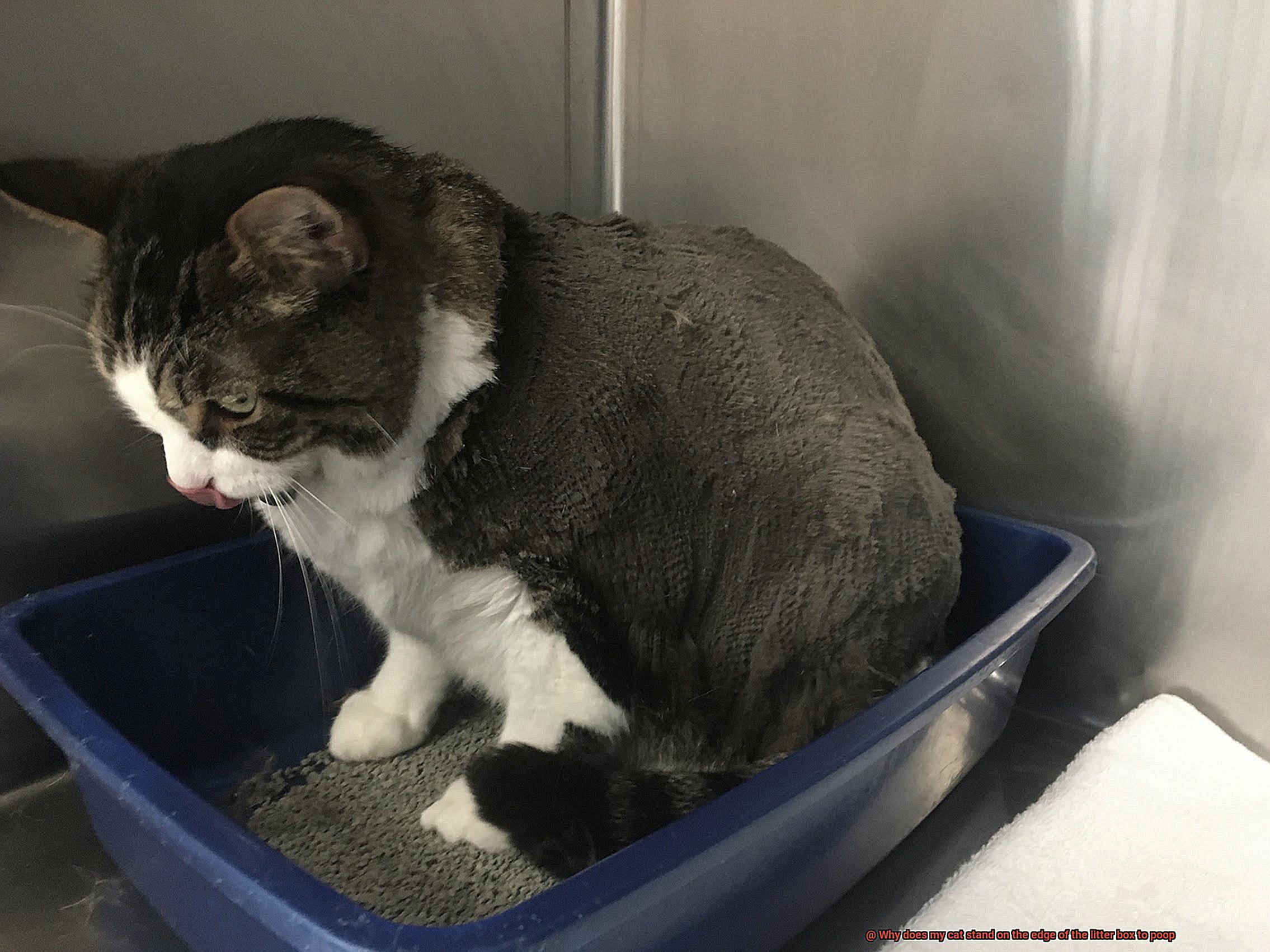
A Matter of Preference
Just like humans have preferences when it comes to our living spaces, some cats have preferences when it comes to their litter box setup. If your cat has always stood on the edge of the box to do their business, they may simply prefer that approach out of habit.
Health Concerns
In some cases, standing on the edge of the litter box could be a sign of an underlying health issue. Cats with joint problems or digestive issues may find it difficult to squat down fully in the box, so they may stand on the edge instead. It’s important to observe your cat’s behavior and consult with your vet if you suspect any health issues.
While standing on the edge of the litter box is usually not a cause for concern, it’s important to ensure that your cat feels comfortable and safe in their litter box environment. Keep the box clean and provide enough space for your furry friend to move around freely.
Avoiding Stepping in Waste
Although it may seem odd, there are several reasons why cats do so, and one of them is to avoid stepping in waste.
Cats are fastidious creatures that don’t like to step in their own waste. By perching on the edge of the litter box, they can navigate their way around soiled litter and avoid coming into contact with it. This behavior is particularly prevalent in cats that have had negative experiences with dirty or unclean litter boxes in the past.
To discourage your cat from standing on the edge of the litter box, you must keep it clean. Scoop out clumps and feces at least once a day, and completely change the litter and wash the box once a week. Additionally, some cats prefer larger litter boxes that allow them more space to move around and avoid stepping in waste.
If your cat continues to stand on the edge of the litter box despite proper cleaning and maintenance, consider switching to a different type of litter or even a different style of litter box. Some cats prefer unscented or softer litters, whereas others may prefer covered or open-style boxes.
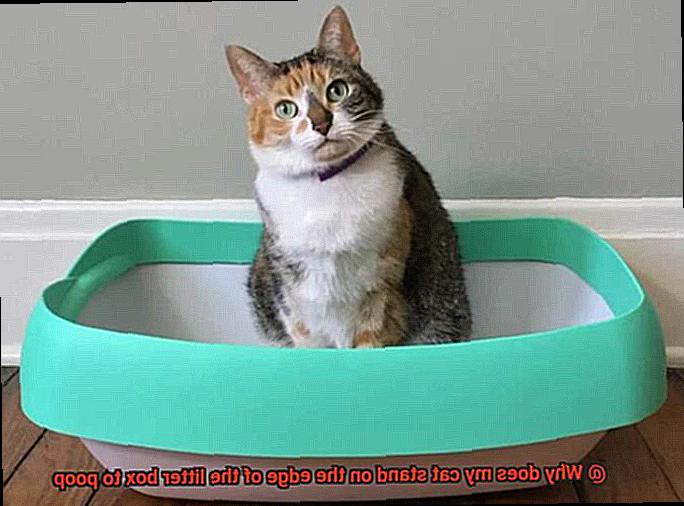
Feeling Secure
They may choose to stand on the edge of the litter box to poop, and you may be wondering why.
Well, it turns out that cats are naturally cautious animals and feel vulnerable when in a confined space like a litter box. Standing on the edge allows them to survey their surroundings and avoid potential threats. It’s all about feeling secure and in control.
Moreover, standing on the edge also provides more room to move around. Cats like to have plenty of space when they are doing their business, and standing on the edge of the litter box gives them a wider range of motion. It’s almost like having a dance floor to themselves.
Sometimes, cats may have had negative experiences with using a litter box in the past. For instance, they may have been startled while using it, leading to anxiety or nervousness about using it again. In such cases, they might try to find ways to feel more in control and secure while doing their business.
To help your cat feel more secure while using the litter box, place it in a quiet and private area of your home. You can also try using a larger litter box or providing multiple litter boxes throughout your home to give your cat more options. Remember to scoop the litter box regularly and keep it clean, as a dirty litter box can make your furry friend feel uncomfortable and insecure.
Discomfort or Pain
While this behavior may seem peculiar, it could be an indication of discomfort or pain. It’s essential to understand the underlying causes and take appropriate measures to alleviate your cat’s discomfort.
Constipation is one of the most common reasons for pain during defecation. When your cat is constipated, they may experience discomfort and strain while trying to eliminate waste. In an attempt to ease the pressure, they may stand on the edge of the litter box and change their position.
Another possible cause of discomfort or pain is urinary tract issues. Bladder stones, infections, and other conditions can make it painful for your cat to eliminate waste. In such cases, your cat may try to adjust their position in the litter box to find relief.
As cats age, they may develop arthritis or other age-related conditions that make it challenging for them to use a standard litter box. Hence, they may choose to stand on the edge of the box or use alternative methods to relieve themselves.
If you notice your cat exhibiting this behavior frequently, it’s crucial to observe any other symptoms they might be experiencing and seek advice from your veterinarian. They can determine if there is an underlying medical issue causing your cat’s behavior and provide appropriate treatment options.
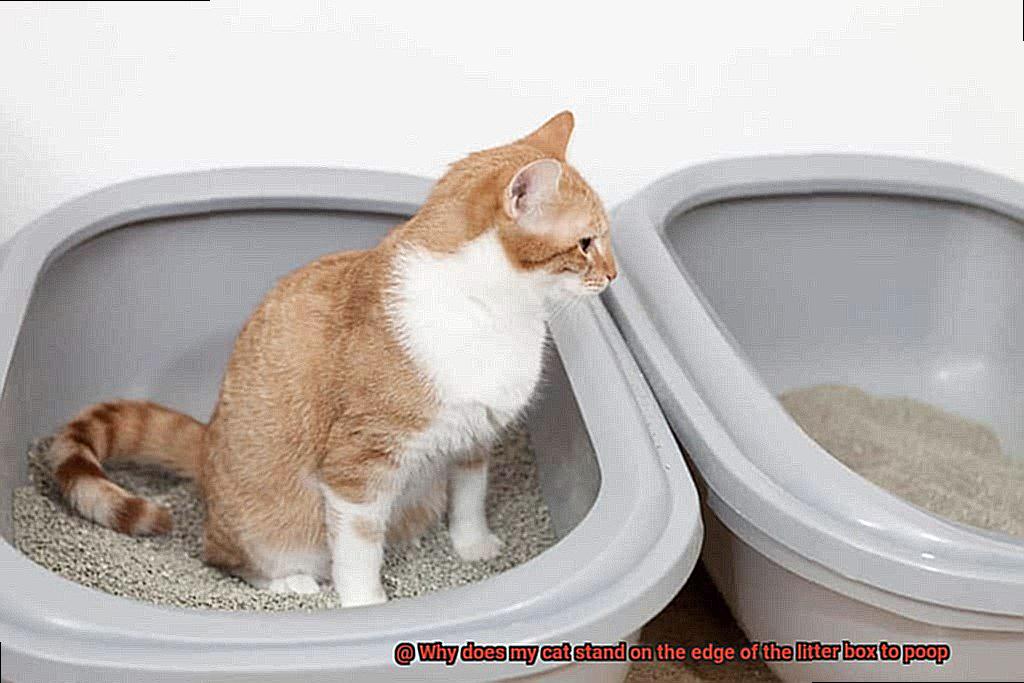
To prevent discomfort or pain while using the litter box, ensure it’s always clean and maintain a quiet and private area for your cat. By addressing any potential medical issues and creating a comfortable environment for your furry friend, you can help ensure they continue to use their litter box with ease and confidence.
Signs of Health Issues Related to Litter Box Habits

That means you should pay extra attention to any changes in those habits, as they could point to underlying health issues that require medical attention. Here are five common signs of health problems related to litter box habits that all cat owners should be aware of:
Frequent Urination
If your cat is suddenly using the litter box more often than usual, it could be a sign of urinary tract infection, kidney disease, or diabetes. These conditions can be serious and require immediate veterinary care.
Straining to Urinate
If your cat is struggling to urinate or producing only a small amount of urine, it could indicate urinary blockage, which is a medical emergency. You should take your cat to the vet right away.
Blood in Urine or Stool
Seeing blood in your cat’s urine or stool can be alarming, but it’s important to stay calm and seek veterinary care right away. This symptom could indicate several conditions, such as bladder infection, kidney stones, or cancer.
Diarrhea or Constipation
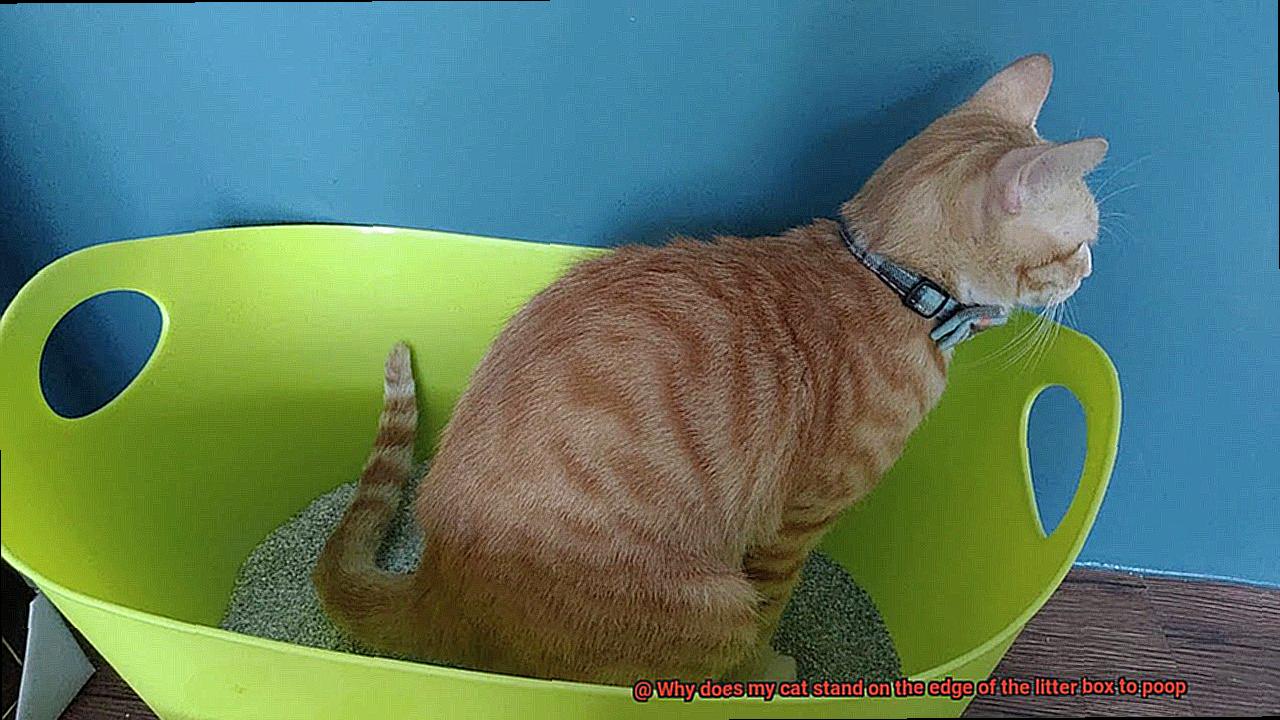
Changes in bowel movements can also be a sign of underlying health problems such as inflammatory bowel disease, parasites or tumors. Keep an eye on your cat’s stool consistency and consult with your veterinarian if you notice any changes.
Avoidance of the Litter Box
If your cat is avoiding the litter box altogether, it could indicate discomfort while defecating or urinating due to medical conditions such as urinary tract infections or constipation. It could also be a sign of stress-related behavior problems that require behavioral modifications.
What Cat Owners Can Do To Address This Issue
The good news is that there are practical steps you can take to address this issue and ensure your cat is using their litter box properly.
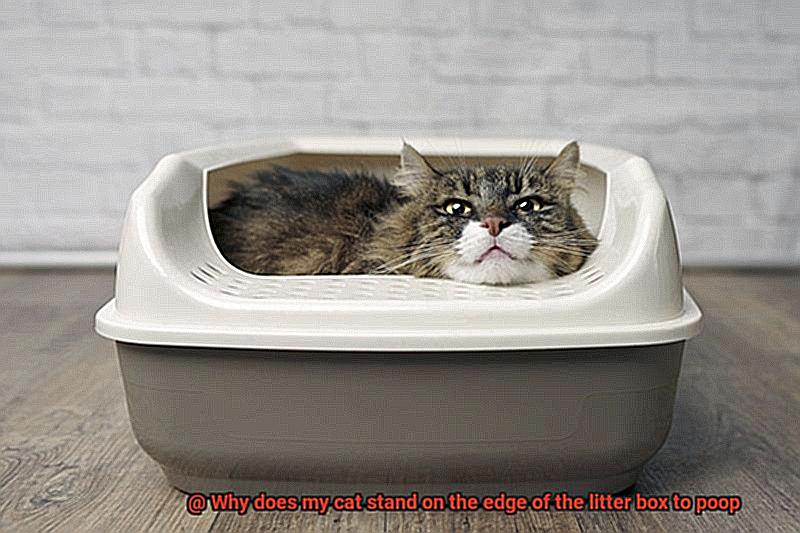
First things first, maintaining a clean litter box is paramount. Cats are naturally clean creatures, and if their litter box is dirty or has a strong odor, they may be hesitant to use it. Be sure to scoop out any waste daily and replace the litter completely every few weeks.
Moreover, experimenting with different types of litter can be beneficial. Some kitties have specific preferences regarding the texture or scent of their litter. Don’t hesitate to try out various options until you find one your cat approves of.
If you have multiple cats or an especially finicky feline, consider providing multiple litter boxes in different locations around the house. This will give your pet options and may encourage them to use the litter box more consistently.
However, if your cat continues to stand on the edge of the litter box despite your best efforts, it may be time to consult with your veterinarian. Standing on the edge of the litter box can sometimes indicate an underlying medical issue, such as arthritis or digestive problems.
Tips for Choosing an Appropriate Litter Box
Choosing the perfect litter box for your furry friend can be a challenging task. There are different types, sizes, and materials to choose from, and each cat has its own preferences. But don’t worry, we’ve got you covered with these tips to help you choose an appropriate litter box that your cat will love.
Size Matters
The size of the litter box is crucial. Your cat should have enough space to move around and dig in the litter comfortably. A good rule of thumb is to choose a litter box that is at least one and a half times the length of your cat. If your cat is standing on the edge of the litter box to poop, it’s a clear indication that the box is too small.
Type of Litter Box
There are different types of litter boxes available in the market, including covered, open, self-cleaning, and top-entry boxes. Covered litter boxes provide privacy and contain odors, but some cats may not like feeling trapped inside. Open litter boxes are easy to clean but may not offer enough privacy for some cats. Self-cleaning boxes are convenient but tend to be more expensive and may not work well with certain types of litter. Top-entry boxes can help prevent litter tracking but may not be suitable for senior or arthritic cats.
Location Matters
Cats prefer a quiet and private area for their litter box, away from high-traffic areas and noisy appliances. Place the litter box in a location that is easily accessible for your cat and doesn’t require them to climb stairs or navigate obstacles.
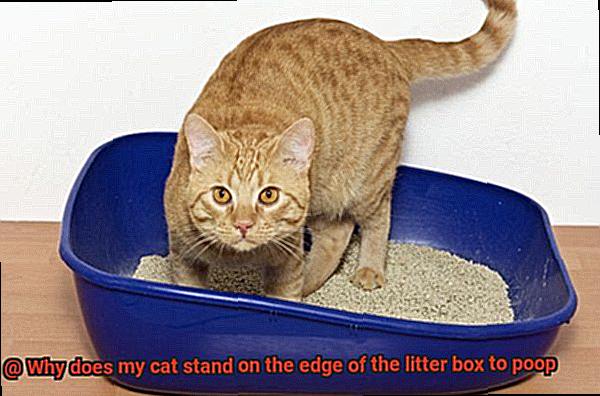
Type of Litter
The type of litter you use in the box can make a big difference in your cat’s comfort level. Some cats prefer clumping litter while others prefer non-clumping, scented or unscented options. Experiment with different types until you find one that works well for both you and your cat.
Cleaning and Maintenance
Keeping the litter box clean and well-maintained is essential for your cat’s health and hygiene. Scoop out the waste regularly, clean the box with soap and water at least once a week, and replace the litter as needed.
by_p6xZhVjI” >
Conclusion
To sum up, cats have their own unique behaviors that can sometimes leave us puzzled. One such behavior is when they stand on the edge of their litter box to do their business. We’ve discovered several reasons why cats choose this approach, including a need for cleanliness, comfort preferences, and even health concerns.
As responsible cat owners, it’s crucial to make sure our furry friends feel comfortable and safe in their litter box environment. This means keeping the box clean and providing enough space for them to move around freely. If your cat continues to stand on the edge of the litter box despite proper cleaning and maintenance, try switching to a different type of litter or even a different style of litter box.
It’s also important to pay attention to any changes in your cat’s litter box habits as they could indicate underlying health issues that require medical attention. By observing your cat’s behavior and consulting with your veterinarian if you suspect any health issues, you can help ensure they continue using their litter box with ease and confidence.
Choosing an appropriate litter box for your cat can also make a significant difference in their comfort level. Factors such as size, type of litter box, location, type of litter used, and cleaning and maintenance should be considered when selecting the perfect one for your furry friend.
Remember that by providing a clean and comfortable environment for our feline companions, we can help ensure they lead happy and healthy lives.







